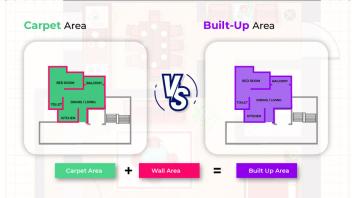The Ultimate Guide for Rent Agreement Format (with Sample)
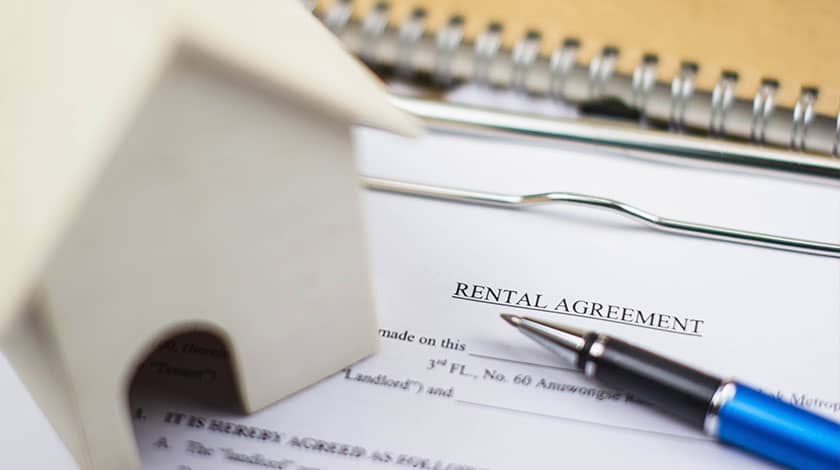
Renting a property is a common practice in the real estate world. Whether you are a tenant looking for a place to call home or a landlord seeking to generate income from your residential property, having a clear and comprehensive idea on the correct rent agreement format is crucial.
Table of Contents:
- What is a Rent Agreement?
- What are Included in the Terms and Conditions for Rental Agreement?
- Documents Required for Rent Agreement Registration
- Process of Preparing a Rent Agreement
- 11 Month Rent Agreement Sample Format
- Type of Tenancy Agreements in India
- Rights and Obligations of the Landlord and Tenants
- FAQs
What is a Rent Agreement?
A rent agreement, also known as a rental agreement or lease agreement, serves as a legally binding contract that outlines the terms and conditions of the rental arrangement between the both the parties.
A well-drafted and mutually agreed-upon rent agreement can prevent misunderstandings, protect the rights and responsibilities of both the landlord and the tenant, and provide a framework for resolving disputes, if any, in a fair and legal manner.
Note: Rental agreements in India are legally binding documents. If either party fails to adhere to the agreement's terms, they could face legal consequences, such as eviction or financial penalties. The introduction of the Model Tenancy Act in 2021 streamlines the rental process and balances the rights and responsibilities of landlords and tenants.
Go To: 11 Month Rent Agreement Sample
What are Included in the Terms and Conditions for Rental Agreement?
In India, the rental agreements follow a specific format and include certain terms and conditions.
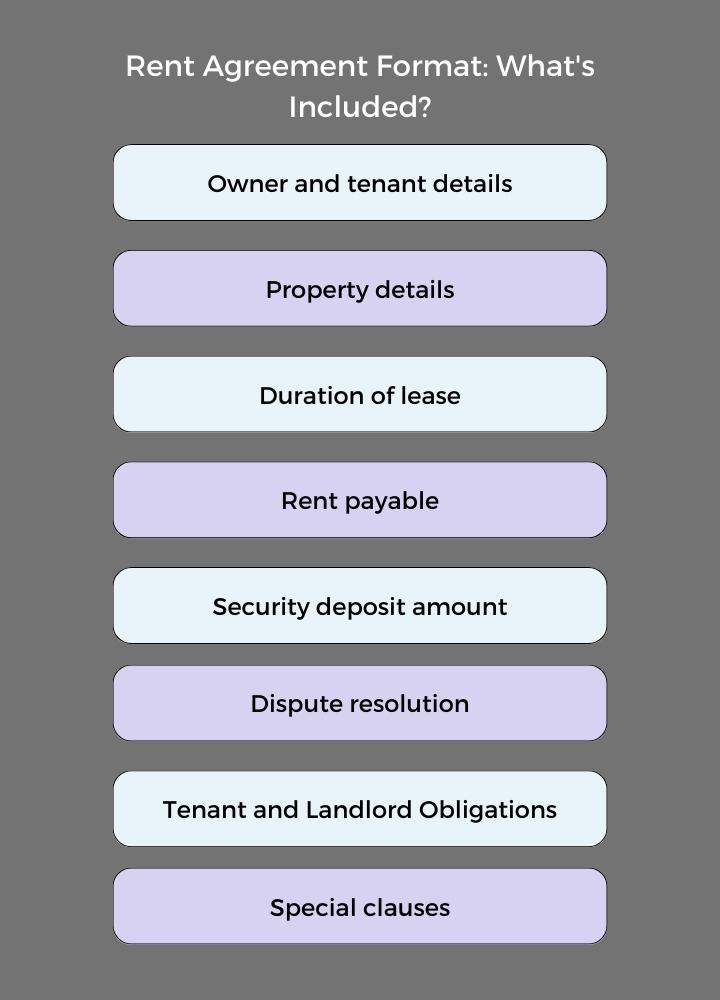
Details of Parties Involved
The rental agreement format includes the full names, addresses, and contact information of both the owner landlord(s) and tenant(s).
Property Details
Complete description of the property being rented, including its address, type (residential or commercial), and any distinguishing features or fixtures included.
Duration of Lease
The commencement date and end date of the agreement. For leave and license agreements, this is typically 11 months, but lease agreements may have longer durations.
Rent Details
The amount of monthly rent, the date by which it should be paid each month, and the mode of payment.
Security Deposit
The amount of the security deposit paid by the tenant at the beginning of the lease, the conditions under which the full security deposit will be returned, and any circumstances under which the landlord can deduct from it.
Maintenance, Repairs, and Utilities
Clarity on who will be responsible for routine maintenance, major repairs, and utility bills, along with details on the amount to be paid towards these charges.
Tenant and Landlord Obligations
Specific duties and responsibilities of both parties, including the tenant's obligation to keep the property in good condition and the landlord's obligation to ensure the property is fit for habitation.
Dispute Resolution
How any disputes related to the agreement will be resolved, often through arbitration.
Special Clauses
These may include special clauses that address specific situations or requirements such as pet policy, subletting, guest policy, and other specific conditions agreed upon by both parties.
-
Pets Policy: If the landlord has specific rules or restrictions regarding pets, it should be clearly mentioned in the agreement. This can include limitations on the number, size, or breed of pets allowed, as well as any additional pet-related fees or deposits.
-
Guest Policy: The agreement should define the rules and limitations regarding guests staying at the rented or leased property, including the duration of their stay and any additional charges that may apply.
-
Renewal Options: If the parties wish to include options for renewing the rental agreement beyond the initial lease term, the renewal conditions and procedures should be clearly outlined.
-
Subletting Policies: If the landlord permits subletting, the agreement should state the conditions and procedures for subletting, including any required approvals or notifications.
-
Early Termination Clauses: In certain circumstances, the tenant or the landlord may need to terminate the agreement before the agreed-upon end date. The agreement should specify the conditions, penalties, or procedures for early termination.
-
Rent Escalation Clauses: Rent escalation clauses address potential rent increases during the tenancy. This clause should clearly outline the conditions under which the rent can be increased, the frequency of increases, and the method for determining the new monthly rental amount due.
Signatures
The agreement should be signed and dated by both the landlord and tenant, indicating their acceptance of its terms. If the agreement is for more than 11 months, it should also be registered and stamped to make it legally enforceable.
Also read: Things to Know Before Renting a House
Documents Required for Rent Agreement Registration
In India, it's mandatory to register rental agreements that are for a term of 12 months or more. Registration involves paying a stamp duty and registration fee, which varies by state. The necessary documents for registration include:
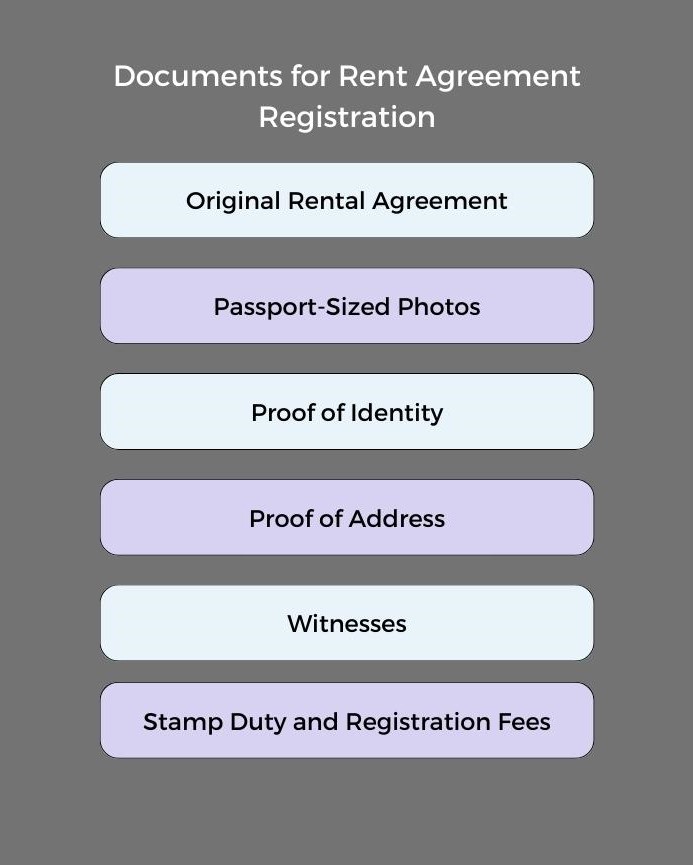
-
Original Rental Agreement: The drafted rental agreement, mutually agreed upon and signed by both parties (landlord and tenant), is required.
-
Passport-Sized Photos: Both the landlord and tenant need to provide passport-sized photographs.
-
Proof of Identity: Any proof of identity such as PAN card, Aadhaar card, Driving License, Voter ID, or Passport.
-
Proof of Address: Documents such as utility bills (electricity, water, etc.), tax paid receipt, or any other document that proves the ownership of the property by the landlord.
-
Proof of Ownership: The landlord should provide proof of ownership of the property. This could include a sale deed, tax receipts, or a certificate of title.
-
Witnesses: Usually two witnesses are required during registration, and their identification documents would also be needed.
-
Stamp Duty and Registration Fees: Stamp duty is a tax on property transactions, payable based on the rent amount, security deposit, and tenure of the agreement. The registration fee is usually a flat amount. Both are usually paid to the Sub-Registrar’s office at the time of registration.
It's important to note that the precise documents needed and the process of registering a rent agreement itself may vary based on local laws and regulations.
What is the Process for Preparing a Rent Agreement?
Creating a rent agreement is a critical step in the leasing process, and doing it correctly can prevent future disputes and legal complications. Here's a step-by-step guide to preparing a rent agreement:
-
Understand the Basics: The first step is to understand the different types of rent agreements (lease agreement and leave and license agreement) and decide which one suits your situation best. Research your local state laws and regulations related to rental agreements as they can vary across states.
-
Detail the Parties Involved: Include the full names and contact information of the landlord and the tenant. If the property is owned by more than one person, all owners should be listed as landlords in the agreement.
-
Define the Property: Clearly describe the property being rented, including its location, type (residential or commercial), and any specific features.
-
Set the Term: Determine the duration of the lease, specifying the start and end dates.
-
Determine the Rent: Establish the amount of rent to be paid, the due date each month, and the payment method. Also, consider including details about late fees, if any.
-
Specify the Security Deposit: Detail the security deposit amount, the conditions for its return, and any situations that might warrant deductions from the deposit.
-
Outline Responsibilities: Clearly state who (landlord or tenant) will be responsible for things like utilities, maintenance, and repairs.
-
Define the Terms and Conditions: This can include rules about pets, noise, guests, and whether the tenant can sublet the property.
-
Discuss Termination: Specify the conditions under which the agreement can be terminated by either party, the notice period required, and any potential penalties for early termination.
-
Dispute Resolution: Determine how any disputes that arise will be handled. It's common to include a clause stipulating that disagreements will be resolved through arbitration.
-
Sign and Date the Agreement: Once both parties agree on the terms, they should sign and date the agreement. It's good practice to have the signing witnessed.
-
Register the Agreement: If the term of the agreement exceeds 11 months, it must be registered with the appropriate local authority (Sub-Registrar's office) to make it legally enforceable. This will involve paying stamp duty and registration fees.
-
Keep Copies: Both the landlord and tenant should keep a copy of the signed agreement for their records.
Note: Remember, a rental agreement is a legally binding contract, and it's crucial to understand all its terms before signing. It's always a good idea to have a lawyer review the agreement, especially for long-term leases or high-value properties.
Also read: Questions to Ask Your Landlord before Renting a Home
Type of Tenancy Agreements in India
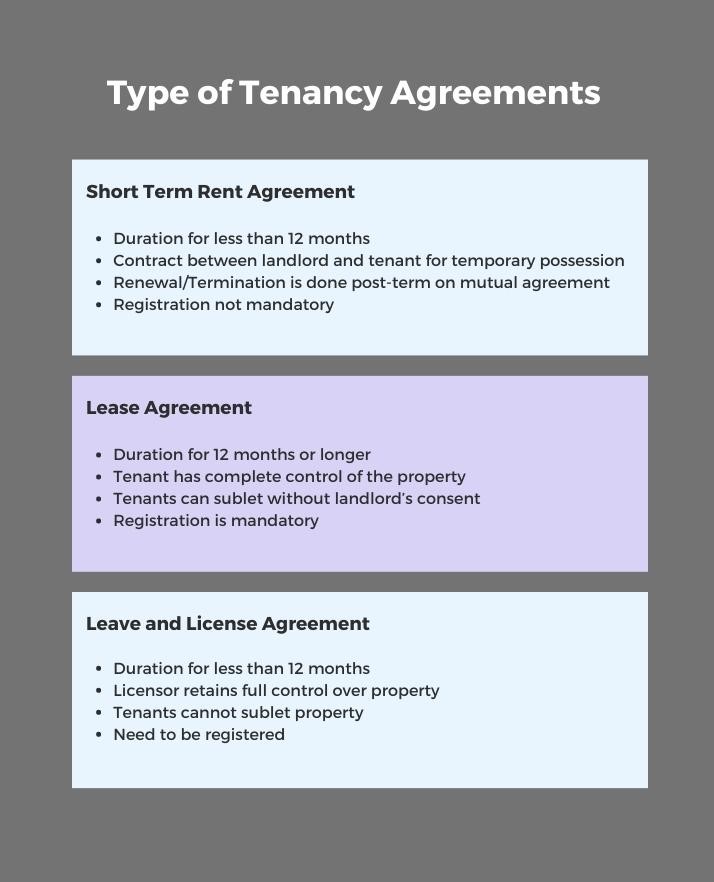
#1 Short Term (11 Month) Rent Agreement
Also known as a Rental Agreement, this is generally for a shorter duration, typically less than 12 months. It is a contract between a landlord and a tenant, where the tenant is given temporary possession of the property for a short duration. The rent, security deposit, and other terms are agreed upon in advance. This agreement does not create any long-term interest in the property for the tenant.
Key Features:
- Duration typically less than 12 months.
- Not mandatory to be registered but should be stamped for legality.
- Typically does not require the payment of a large sum of money in advance.
- Provides flexibility to both landlord and tenant.
- Renewal or termination of the agreement can be done after the end of the term, subject to mutual agreement.
#2 Lease Agreement (Long Term)
This is also known as a Lease Deed and is generally made for a longer duration, commonly more than 12 months. It is a contract between a landlord and a tenant where the tenant is given possession and use of the property for a longer duration. The lease agreement outlines the terms and conditions of the lease, such as the rent to be paid, the term of the lease, and other rights and responsibilities of both parties.
Key Features:
- Duration is generally more than 12 months.
- Needs to be registered with the Sub-Registrar's office.
- Tenant gets exclusive possession and use of the property for the lease term.
- The rights and responsibilities of both parties are defined.
- Early termination often involves a penalty.
#3 Leave and License Agreement
A Leave and License Agreement grants leave to the tenant to enter and use the property for a temporary period. This agreement is not a lease but a grant of leave to use the premises. The tenant or licensee does not gain any interest in the property but merely has the right to use it for a specified period. This type of agreement is unique to Maharashtra and some other states.
Key Features:
- Provides the licensee with a right to occupy the property for a limited duration.
- Does not create a transfer of interest from the landlord to the tenant.
- Generally easier to evict a tenant under a leave and license agreement as compared to a lease.
- Also needs to be registered, and the licensee may need to pay a security deposit to the landlord.
- Is less permanent in nature than a lease agreement.
Also read: Renting a Home: The Good, The Bad, and What You Need to Know
11 Month Rental Agreement Format Sample
This agreement of lease is made and executed in ______________[City, State] on this ______________ [Date, Month, Year] between:
______________ [Landlord Name], residing at ______________ [Landlord Address, City, State, Pin Code] Hereinafter referred to as “THE LESSOR” of the ONE PART.
And
______________ [Tenant Name], residing at ______________ [Tenant Address, City, State, Pin Code] hereinafter referred to as the “LESSEE” of the other Part; Hereinafter referred to as "THE LESSEE" of the OTHER PART AND WHEREAS the Lessor has agreed to grant and the Lessee has agreed to accept a lease of residential premises situated on ______________ [Property Address, City, State, Pin Code] particularly described in the schedule here under referred to as the “THE SCHEDULED PREMISES" on the subject to the terms and conditions hereinafter set out.
NOW THIS AGREEMENT WITNESSETH THE TERMS AND CONDITIONS OF THE LEASE:
1. The rent payable by the Lessee for the Scheduled Premises shall be a sum of ______________ [Monthly rent amount in numbers and words] per month payable before ______________ [Date/day] of every month.
2. The rent and charges for the amenities, fittings, and fixtures payable to the Lessor by the Lessee shall be enhanced by ______% of the last amount paid at the end of 11 months.
3. The lease shall commence on or from the ______________ [Lease start date] and shall be in force initially for a period of 11 months and can be renewed according to the mutual understanding of both the parties.
4. The lessee is liable to pay the Lessor a sum of INR. ______________ [Security deposit amount in numbers and words] as security deposit, which the Lessor hereby acknowledges the said amount and the same be held by the Lessor as Security Deposit during the continuance of the lease and shall be repaid to the Lessee free of interest at the end of the period of the lease.
5. The Lessor shall pay all taxes, deposits, assessment charges and other outgoings whatsoever of every description including corporation charges will be levied unto the Lessor and shall keep the premises free from all encumbrances.
6. Lessee shall pay the electricity charges directly to the concerned authority as per the power units utilized every month during the period of the lease.
7. The Lessee shall pay the Lessor water charges every month during the period of the lease. These charges are INR. ______________ [Amount in numbers and words] every month.
8. The Lessee shall pay the lessor maintenance charges of INR. ______________ [Amount in numbers and words] every month during the period of lease for maintaining the common utility area.
9. If any damage is caused to the premises, fittings. fixtures and painting, the Lessee must bear the damage charges to the Lessor. The damage charges can be claimed by the lessor by deducting from the security deposit.
10. The Lessee shall be entitled and permitted to use the Schedule Premises for residential purposes only and shall not use or permit for business purpose.
11. The Lessee is not entitled or permitted to assign, underlet, or sublet the scheduled Premises or any part thereof or part with possession of the demised property or any part thereof to anybody whatsoever.
12. The Lessee hereby reserved and observing and performing the terms, conditions and covenants of the lease herein contained shall be entitled to quiet possession and peaceful enjoyment of the scheduled premises without any manner or let, hindrance, interruption or disturbance by or from the Lessor.
13. The lease shall be terminated under all or any of the following circumstances, namely:
- By efflux of time.
- In the event of non-payment of rent for a period of ____ [Number of months] consecutive months.
- In the event of breach by either party of the terms, conditions, and covenants hereof.
- By giving ____ [number of months] month prior notice from either party.
14. The Lessee shall verify and confirm the items listed in Annexure 01 during the time of possession of the scheduled premises. The Lessee shall deliver back the vacant possession of the scheduled premises as listed in Annexure 01 to the Lessor immediately up to the expiry of the said term or on earlier termination if any, in good and rentable conditions, subject to reasonable wear and tear, upon which the Lessor shall return the Security Deposit free of interest less any lawful deduction immediately to the Lessee without delay.
ANNEXURE 01
List of fixtures and fittings provided in [Property Address, City, State, Pin Code]:
- Item 1
- Item 2
- Item 3
______________ [Property Address, City, State, Pin Code] falling in the category, ______________ [Independent House / Apartment / Farm House / Residential Property] and comprising of ______________ [X Bedrooms], ______________ [X Bathrooms], ______________ [X Kitchen]
IN WITNESS, WHEREOF THE LESSOR AND THE LESSEE have set respective signatures, to this agreement of lease on ______________ [Date, Month, Year] herein above mentioned in the presence of witnesses.
WITNESSES:
1. [Witness1 Signature & Name]
2. [Witness2 Signature & Name]
[Lessor Signature & Name]
Lessor
[Lessee Signature & Name]
Lessee
Rights and Obligations of the Landlord and Tenants
Tenant's Rights and Responsibilities
The agreement should outline the rights of the tenant, such as the right to peaceful enjoyment of the rented property, privacy, and protection against unfair practices, illegal activities or discrimination.
It is essential to clearly state the tenant's responsibilities, including timely payment of rent, proper use and care of the property, adherence to rules and regulations, and notification of any damages or necessary repairs.
Landlord's Rights and Responsibilities
The landlord's rights should be clearly defined in the agreement. This may include the right to receive rent on time, access the property for inspections or repairs, and take appropriate action in case of lease violations.
The agreement should outline the landlord's responsibilities, such as all tenant repair requests ensuring the property is safe and habitable, making necessary repairs in a timely manner, and respecting the tenant's privacy.
Also read: Rent Rules and Regulations for Property Owners and Tenants
FAQs
1. Will the Model Tenancy Law cover all rent agreements?
The Model Tenancy Law serves as a guide for the states in India to draft their own rental laws and regulations. While it provides a framework for standardizing rent agreements and addressing key aspects such as, rent control laws, dispute resolution, and tenant protection, each state has the flexibility to make modifications and additions based on their specific requirements. Therefore, it is important to refer to the rental laws applicable in your state to understand how they align with the model tenancy law and whether they cover all types of rent agreements.
2. What is the role of rent agreement in claiming tax deduction?
Rent agreements play a significant role in claiming tax deductions, especially for individuals who are salaried and live in rented accommodations. The rent payment can be claimed as a deduction under the Income Tax Act, subject to certain conditions.
To claim tax deductions, the rent agreement should be properly drafted, include the correct rental amount, and be supported by rent receipts as evidence of payment. It is advisable to consult a tax advisor or refer to the relevant tax laws in your jurisdiction to understand the specific requirements and provisions for claiming tax deductions on rent.
3. Is it compulsory to register a rent agreement?
Yes, in India, it is mandatory to register rent agreements that are for a term of 12 months or more. Even for agreements with a term less than 12 months, registration is highly recommended for legal protection in case of disputes. The registered agreement serves as a legal proof of residence and a binding contract between the landlord and the tenant.
4. How can I change the terms of my rental agreement?
To change the terms of your rental agreement, both parties - the landlord and the tenant - must mutually agree to the changes. This usually involves a discussion about the proposed changes, followed by the drafting of an amendment to the rental agreement. The amendment, which details the changes, is then reviewed and signed by both parties. It's recommended to consult with a legal professional during this process to ensure all changes are lawful and fair.
Also Read: Factors that Affect Rental Prices
Understanding the rental agreement format is vital for both landlords and tenants in the realm of real estate. This ultimate guide has provided a comprehensive overview of the various aspects of a rent agreement, from its types and essential elements to financial considerations, rights and responsibilities, special clauses, legal aspects, negotiating strategies, documentation, and more.
By having a well-drafted and mutually agreed-upon rent agreement, both parties can establish a clear understanding of their rights and obligations, prevent disputes, and ensure a smooth and harmonious tenancy. Whether you are a landlord or a tenant, it is crucial to familiarize yourself with the local laws and regulations governing rent agreements in your jurisdiction to ensure compliance and protect your interests. A carefully crafted rent agreement sets the foundation for a successful rental relationship and offers peace of mind to both parties involved.



